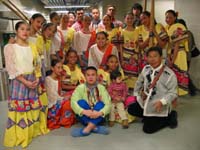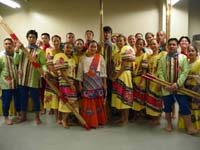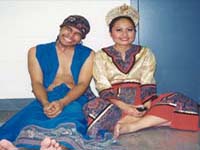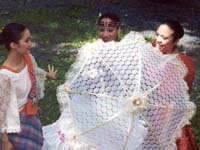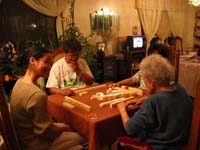After thirty-seven years of promoting and preserving Philippine culture and dance in Canada and abroad, what is it like behind the scenes as a member of the Fiesta Filipina Dance Troupe before the curtain rises or after the lights go out and the curtain falls? Here is a glimpse of life backstage from the eyes of a Fiesta Filipina dancer.
Before each annual concert in September, chaos reigns at Fiesta’s new home, The Living Arts Centre, in Mississauga, Ontario. Tupperware boxes, holding their precious cargo of costumes and props, litter the halls of the dressing rooms. Dancers can be seen skimming through the labels of the boxes to identify the costumes associated with their respective dances. This is all driven by the LIST. It is from this list of dances and costumes that the two-hour program for the evening is derived.

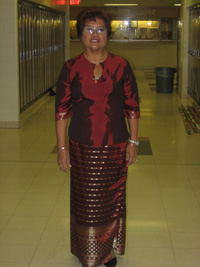
So, who is the mastermind of the LIST? It is non-other than Estrellita Aguinaldo. She has been there from the early years of the dance troupe, working alongside her husband, George Aguinaldo, who is the Artistic Director and creative strength of the troupe. Tita Estring, as she is commonly referred to by her colleagues and dancers, is the main production manager of each performance. She is a tireless and giving worker, who determines the performers who will be assigned to each dance, while ensuring that there will be enough time between quick changes. It is work that involves long hours into the late evening. But, her work does not stop there. She must ensure that all the costumes and props are available for the performance. It is a tough assignment yet it is a labour of love.
As Tita Estring manages the evening, dancers all know to steer clear of her to avoid adding more stress to her. As they collect their belongings, dancers gather among their groups of friends to relieve the anxiety at a performance that marks the end of another season.
Practical jokes and pranks abound as dancers try to find an outlet for their nervous energy. Some decide to catch a little shut eye from working late the night before, preparing for exams, or staying late at a party the previous night. Also, it is not uncommon to see romantic relationships form between dancers as they huddle close and spend more time together. Others chat over a bowl of pansit or Filipino noodles, together with a healthy sample of egg rolls. In certain corners, some dancers run through the footwork and choreography of their dances.
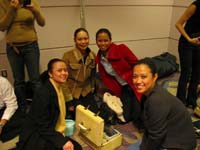
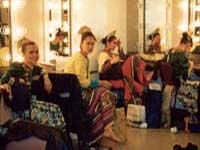
After thirty-seven years of promoting and preserving Philippine culture and dance in Canada and abroad, what is it like behind the scenes as a member of the Fiesta Filipina Dance Troupe before the curtain rises or after the lights go out and the curtain falls? Here is a glimpse of life backstage from the eyes of a Fiesta Filipina dancer.
Before each annual concert in September, chaos reigns at Fiesta’s new home, The Living Arts Centre, in Mississauga, Ontario. Tupperware boxes, holding their precious cargo of costumes and props, litter the halls of the dressing rooms. Dancers can be seen skimming through the labels of the boxes to identify the costumes associated with their respective dances. This is all driven by the LIST. It is from this list of dances and costumes that the two-hour program for the evening is derived.
Just minutes before the performance, the group gathers and a final prayer is said. Then, the group disperses and disappears into the dark wings of the stage as they assume their position. The tribal drums beat and the performance begins.
At the end of the performance, everyone is asked to collect their costumes and props and to return them to their appropriate bins. The performers quickly remove their make up while female performers remove the pins that hold their hair in a tight, perfect bun.
After cleaning up, some dancers decide to meet for a late night meal at Mississauga’s only 24-hour Chinese restaurant, Tremendous. Others decide to gather at the local pub to unwind. Of course, what social event would be complete without a friendly game of mahjong?
After thirty-seven years of promoting and preserving Philippine culture and dance in Canada and abroad, what is it like behind the scenes as a member of the Fiesta Filipina Dance Troupe before the curtain rises or after the lights go out and the curtain falls? Here is a glimpse of life backstage from the eyes of a Fiesta Filipina dancer.
Before each annual concert in September, chaos reigns at Fiesta’s new home, The Living Arts Centre, in Mississauga, Ontario. Tupperware boxes, holding their precious cargo of costumes and props, litter the halls of the dressing rooms. Dancers can be seen skimming through the labels of the boxes to identify the costumes associated with their respective dances. This is all driven by the LIST. It is from this list of dances and costumes that the two-hour program for the evening is derived.
Just minutes before the performance, the group gathers and a final prayer is said. Then, the group disperses and disappears into the dark wings of the stage as they assume their position. The tribal drums beat and the performance begins.
At the end of the performance, everyone is asked to collect their costumes and props and to return them to their appropriate bins. The performers quickly remove their make up while female performers remove the pins that hold their hair in a tight, perfect bun.
After cleaning up, some dancers decide to meet for a late night meal at Mississauga’s only 24-hour Chinese restaurant, Tremendous. Others decide to gather at the local pub to unwind. Of course, what social event would be complete without a friendly game of mahjong?

Outside of the fast-paced atmosphere of a scheduled performance, many dancers form strong friendships with their colleagues. At times, these friendships last a lifetime as relationships build on their common interest of Philippine music and dance. Some romances that begin in the troupe even lead to marriage.

In addition, the popular Philippine debut or coming-of-age party for a young woman of Philippine descent on her eighteenth birthday, is a common event where dancers from the troupe take part. Another popular destination is the golf course. There is also the annual Christmas party.

Others get involved further in the Filipino-Canadian community as they strive to make a difference. Such involvement includes CAFÉ or Canadian Awareness of the Filipino Experience, which is an annual event dedicated to not only promoting Philippine culture among youth, but it also provides a forum for addressing social, cultural and political issues from a Filipino-Canadian perspective.
So, after thirty-seven years, the Fiesta Filipina Dance Troupe continues to thrive, providing a means for members to not only experience the thrill of performing, but to have a sense of family and of course, have fun.



